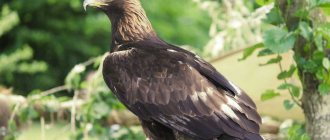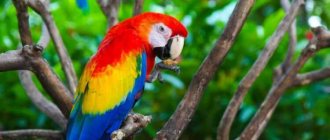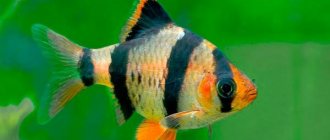Having a great desire to acquire a winged companion, you are probably wondering what types of parrots are acceptable for home keeping? These birds in a bright outfit are pleasing to the eye of many. And their imitation capabilities delight us. Some species are capable of reasoning; artificial intelligence cannot compare with such philosophers. In addition, there is no need to walk them several times a day, or endlessly collect wool from clothes. It’s easy to surprise guests with chirping exoticism in the house. And to make the parrot happy, before moving it into the house, we advise you to study the species differences and features of keeping.
Variety of species of domestic parrots
Over 350 species of parrots live on the planet. Most of them are excellent for keeping at home; other parrots are so few that they are rare in captivity.
Keeping a parrot in an apartment places a certain responsibility on the owner. Before getting a bird, weigh your options. For example, large birds cannot be kept in a small cage, and food for large birds is not suitable for small breeds. In addition, there are species that should not be owned by inexperienced owners, otherwise serious problems may arise.
- Large species of domestic parrots include cockatoos, grays, macaws and amazons.
- The middle ones include the Ozherelidae, Loriidae, Kakariki, Corellas, Rosellas, Caiques and Kalita.
- Small breeds include budgies, lovebirds and passerines.
No matter how attractive the bird may be to you, make your choice responsibly, because at home many parrots live 15-20 years, and some even 70-80 years. Each species has its own characteristics, abilities, character and requirements for living conditions.
Lovebird
Another small parrot, but still larger than a budgerigar. This is more of an ornamental bird; if you keep them in pairs, then they will have enough communication with each other. It is almost impossible to persuade a couple of lovebirds to communicate with their owner, much less learn a few words.
It's another matter if there is only one parrot. Then you become his couple: get ready to communicate with him all your free time. They can be taught 50-70 words, simple commands and rules in the apartment. You can then place a couple with an already trained parrot, but be sure to place a girl with a boy.
Small parrots live up to 15 years, are easily accustomed and live happily in an apartment if they are provided with comfortable conditions. These birds prefer to live in a flock, but are able to communicate only with humans.
Small parrots
The advantage of small bird species is that they do not take up much space, are easy to care for, food for them is inexpensive and even novice breeders, including children, can keep them at home.
Wavy
The most popular type of pet parrot is the budgerigar. These birds are cheerful, active, friendly towards people, affordable and easy to keep. Many people also get budgies because they have a good ability to imitate human speech.
Wavys feel great both in pairs or flocks, and in single keeping. The main thing is that the owner pays attention to the pet.
Did you know? Budgerigars kept alone quickly get used to people, become more sociable and learn to talk more easily.
Talking domestic parrots are males. Boys are more capable of onomatopoeia, so choose them when purchasing.
The size of the birds does not exceed 19 cm, so a small cage is purchased for them. Although, of course, it is important to let your pet out of the cage to fly around the room from time to time.
The natural green color of the plumage of budgerigars, thanks to selection, has been enriched with a variety of colors, which has led to the appearance of almost 200 color varieties.
Good living conditions make it possible for these birds to live at home for 15-20 years.
Passeriformes
Some of the smallest parrots are passerines. Body size is no more than 14.5 cm. They are easy to care for, friendly, and learn to talk well. They love to play and spend a lot of time with their owners.
The advantage of this type of pet parrot is that they are not noisy. Therefore, owners who love peace and quiet should have such pets.
True, passerine parrots also have a drawback - they are quite aggressive towards other species of birds, which is why they are usually not kept in a flock. There should be no more than 2 pets in a cage.
The lifespan of this species is up to 20 years.
Lovebirds
Thanks to their bright colors and temperament, lovebirds are increasingly gaining love among bird lovers. It is difficult to teach them to talk, but they will always delight you with their activity and mobility. Watching these cheerful birds, you are always charged with optimism.
It is best to keep lovebirds in pairs. They have a very touching attitude towards their partner (for which they received such a “telling” name), they like to sit closely pressed to each other.
The colors of these parrots are varied: the green main color of the plumage combines beautifully with pink, yellow, and red colors. Pure white lovebirds, deep yellow ones, and also cobalt ones have been bred.
Budgerigar
The most accessible of all, but not the stupidest. Budgerigars came from Australia, where they are even eaten. These are small flocking birds, they are quite comfortable to keep at home, and they are easy to train.
Males of this species learn up to 150 words, as well as melodies and sounds, such as a telephone ringing. Females are not so frivolous, so they limit themselves to the most necessary words - rarely more than 50. They require a lot of communication, so you need to have several, or be ready to communicate with the baby 24/7.
Medium sized parrots
For the most part, medium-sized domestic parrots are also not particularly picky about their living conditions. But the cells for them must be much larger than for small species. Often an aviary is equipped in an apartment for such birds to provide them with sufficient space to live.
Aratinga
These birds reach 16-35 cm. They are very positive, cheerful, playful, they adore human attention, for which they are lovingly called “sticky birds”. The plumage of the aratinga is bright and colorful, it perfectly combines red, yellow, blue and green colors, although photos of these parrots do not always convey their beauty:
Aratingas are easy to keep at home, but they are considered destroyers, capable of turning furniture into splinters in a short time with their strong beaks. To distract them from this activity, you need to provide a large number of wooden toys and branches.
These birds really need the attention of their owners. If you like to spend a lot of time with your pet, in the “face” of the Aratinga you will get an extremely affectionate companion who takes great pleasure in communicating with you.
The disadvantage of these birds is their loudness. In the mornings or evenings they often make loud, shrill calls. Although they can scream throughout the day, expressing both displeasure with something and joy.
These pet parrots have the ability to reproduce human speech and can learn several dozen words and phrases. They are well trained in a variety of tricks.
Aratingas can live 15-30 years in captivity.
Kaiki
White-bellied caique parrots are funny birds that move with original jumps. For these abilities, many owners have such pets. They are artistic, restless, and easily learn a wide variety of tricks. True, they are completely unteachable in human speech, but they perfectly imitate various sounds: the ringing of an alarm clock, a crying child, the noise of household appliances, and so on.
The two varieties of white-bellied caiques, the red-headed and the black-headed, differ in the color of the plumage on their heads. The size of the birds is 23-25 cm.
They can scream loudly and shrilly, they like to chew on something, but these are very trusting and affectionate birds that become true friends to their owners.
Under optimal conditions, domestic caique parrots can live 25-30 years.
Kakariki
Kakariki are called jumping and running, and also the most restless parrots on the planet. They don’t sit still, they constantly find something to do: tinker with something, dig for it, find it. They run and jump, not only along the bottom of the cage, but also along the ceiling. Therefore, the bird cage must be spacious enough to give them enough room to maneuver.
Males can be taught to talk, but their “vocabulary” will be small. The female is not a talking bird, but she is calmer. Males of kakariki are usually bully and restless.
The birds reach sizes up to 25 cm. The main color of the plumage is green. Life expectancy is 15-20 years.
Corella
Nymphal cockatiels are not much inferior in popularity to budgies. These graceful birds with a beautiful crest are peaceful, making them suitable as pets for beginners and even children.
Corellas are gentle creatures; they love to communicate with people and cuddle up to them. They sing beautifully, can whistle and imitate human speech. You need to spend a lot of time with them; they can get sick from lack of attention.
A touching crest on the head, bright “ruddy” cheeks, a curved beak reminiscent of a smile, different shades of gray in the plumage make the bird very elegant. The body size of cockatiels reaches 32-34 cm. They live at home for an average of 20 years.
Laurie
In Dutch, the name of these unusually colorful birds means "clown". Loris are intellectually developed birds, affectionate, extremely playful, and easily tamed.
Like domestic parrots, these birds can be very trusting, quickly make contact with a person, even a stranger, and are happy to communicate with children. Not aggressive towards other pets. Loneliness is easily tolerated, as they will always find something to do.
But they have two serious drawbacks:
- piercing creaky screams;
- liquid droppings with which the lorises seem to mark their territory everywhere.
Speakers
One of the cutest things about parrots for many people is their ability to speak or imitate noises. It is for this reason that these birds are often used as pets.
Eclectus
Eclectus was first discovered in the Solomon Islands. This is the most caring, gentle and calm of the large breeds of parrots. Birds are very friendly to children. Not aggressive. The diet includes foods high in fiber. It is unacceptable to feed them fatty foods. Very capable of learning. Vocabulary can be more than 100 words.
Estimated lifespan is 40 years. The weight of an adult male reaches 500 grams.
Laurie
One of the most beautiful and colorful birds is the loris. Loris breeders know that, in addition to beauty, these individuals are distinguished by sloppiness. You need to be prepared for this.
Excellent trainability. Their vocabulary can be around 70 words. Lories do not like to be in silence. If you can’t spend time with your pet, just turn on the radio or TV.
Others
The vocabulary of talking parrots differs significantly from each other.
Approximate vocabulary by type:
- Gray Gray – 350-400 words;
- Amazon – 50-60 words;
- ara – 20-30 words;
- cockatoo – 10 words;
- lovebirds – 15 words;
- rosella – 10;
- tiger parrot – 20-30 words;
- cockatiel – 10;
- budgerigars – 100-150 words.
Large parrots
Representatives of large breeds of domestic parrots are often compared in terms of intelligence to 3-5 year old children. They are intelligent, artistic, and able to learn and reproduce many words and phrases. Moreover, one often gets the impression that they do not just imitate human speech, mindlessly pronouncing words, but understand their meaning and insert remarks at the right moment.
Large parrots become very attached to their owners and become their true friends. In return, they require a lot of attention, they need to be trained from the first days, since most of them tend to dominate. These are strong, temperamental birds, capable of causing serious injury with their strong beaks if not trained correctly.
Most of them are not suitable for novice bird owners, as they are picky about the living conditions, diet and even the character of their owner.
They require spacious metal cages, or better yet, enclosures. It’s even better if a whole room is equipped for such birds. They need constant human contact. They are long-lived.
Amazon
These birds with bright green plumage are one of the large pets that novice owners can keep. Amazons are by nature friendly, inquisitive, active, excellent talkers, attached to their owners. On the other hand, the Amazon is a noisy bird; it can be impudent and quarrelsome if you do not train it.
The sizes of Amazons, depending on the variety, range from 25 cm to 45 cm. An amazing feature of parrots is the ability to accurately reproduce the intonations of the person teaching them, especially when it comes to singing. They sing great, whistle melodies, talk and imitate the voices of animals.
The lifespan of Amazons is 50 years. There is evidence of a long-lived species of this species, living for 70 years.
Macaw
Gorgeous birds, to which superior epithets are usually applied: the rarest, largest, most expensive parrots in the world. They grow to almost 1 meter. Their prices are in tens of thousands of dollars. The plumage of the birds is bright, contrasting, and does not leave any person indifferent.
Macaws are temperamental, touchy, even vengeful. They constantly strive to dominate, so it is important to train and educate them from the first days of their appearance in the house. They are noisy and love to test the strength of everything that lies poorly with their strong beaks.
Jaco
The most popular smart parrot. It was a representative of the gray species that was included in the Guinness Book of Records as the smartest parrot. This baby will also live to be 60 years old if quality care is provided - unfortunately, Grays are very demanding of their conditions. And they need training; if you don’t do it, the baby will grow up aggressive.
Jaco easily learns new words, sounds, and melodies. Many people's vocabulary will be smaller than this bird can learn! In terms of intelligence, they are at the level of a German Shepherd, they can be taught any commands and skills.
How to choose and where to buy a pet parrot
Having figured out your preferred type of parrot for home keeping, all that remains is to purchase it. You have already prepared a cage or enclosure where your pet will live. Feeders, drinking bowls, toys and other accessories found their place in it. Now it is important to understand where you will buy birds:
- in a nursery or from a trusted parrot breeder - in this case, it is more likely that the bird was born and raised in good conditions in compliance with all the rules. You will receive documents for her, which will indicate her age, place of birth, state of health, often even gender. However, you will have to pay a fairly high price for good conditions for raising your future pet;
- In pet stores you need to look at the conditions in which the bird is kept, the condition of the cage, whether it is cramped there, what kind of food it has, even what kind of litter it has. It is not uncommon that temporary living conditions are created for parrots for sale that do not take into account the characteristics of the bird, hygiene is not observed, low-quality food is used, etc. In such conditions, the parrot receives extreme stress, from which it is not easy for it to recover later. But the price for such birds is lower than that of professional breeders;
- parrots are even cheaper in bird markets, but the conditions in which they are kept leave much to be desired. There is often a very real risk of buying an old and sick bird;
- according to advertisements - when buying a bird from hand, you will not know in advance what difficulties you will have to face. It is not known how the previous owners treated the parrot; it is not always possible to find out its exact age. They can even sell wild birds. You will encounter difficulties in taming, often no efforts in this direction on the part of the new owners bring success. But such birds are cheaper than other options.
Which parrot to choose from these options is up to you. Sometimes you can see the state of health of a bird by external signs. If a bird with smooth plumage, a clean beak, legs and area near the cloaca, as well as shiny eyes without any secretions, is active and looks at you with curiosity, perhaps this is your pet parrot, with whom you will live many happy years, filled with fun, enthusiasm and great mood.
Whatever parrot you choose to keep at home, create conditions for it in which it can live for a long time. You will find some useful tips in this video:
Amazon
A rare guest in our latitudes, you have to try hard to buy Amazon. This is a large parrot, it will need a large enclosure and really a lot of toys, but the pet will live up to 60 years. Amazons are distinguished by incredible intelligence, but, unfortunately, not in favor of humans.
The pet will constantly come up with entertainment for himself, remember and repeat all the sounds around him, and open the cage if he is bored in it. The question here will be not how to train, but how to keep him busy so that he stops training. With proper training, this is the best pet on the list.
Why is the parrot screaming?
Parrots are the loudest pets, because in nature they had to notify a flock several kilometers away. At home, they scream more often only because they are under extreme stress.
The parrot is a gregarious, and therefore social, creature. Even together they are more comfortable than alone. But if there is only one parrot, then a person is obliged to work with it, talk to it and teach it something.
When the owner cannot pay attention to the bird, he should give the parrot intellectual games: macrame, bells, sticks, puzzles with treats.
If the bird is bored and has only a bowl of food and a cage door for entertainment, then it begins to invent activities for itself. Tip the bowl, open the door, remove the paint from the rods. Is the owner swearing? The bird is bored and cannot entertain itself with anything, it begins to scream. And if this is not possible, then he becomes depressed and dies.
Cockatoo
Distributed on the Australian continent, the islands of Indonesia and New Guinea. A feature characteristic of most species is a movable crest of feathers on the head, often contrasting with the main plumage. Coloring occurs in white, black, pink and yellow. Body length is 30-70 cm. They are long-lived parrots.
This is an artistic, affectionate and cheerful bird. Conversational abilities are small; he can memorize several dozen words. But it is easy to teach her to dance and perform various tricks using her wits.
Cockatoo parrot
Negative qualities include a capricious, vindictive, and loud character in some individuals. In addition, they tend to become attached to one of the family members, disliking others.
More often in captivity you can meet:
- white;
- pink;
- yellowtail;
- bare-eyed;
- Inca cockatoo;
- goffryna;
- Moluccan cockatoo.
Representatives of the breed reproduce well in captivity.
Conditions of detention
It is better to keep parrots in a cage most of the day: in an apartment they can get hurt or do something bad. For small parrots, a cage of 50 cm in height is enough; for medium ones, an aviary is needed, and for large ones, up to a whole room. By the way, most parrots are calm towards representatives of their own species, but are intolerant of other species of parrots.
Remember that the parrot came to you from equatorial latitudes; in the apartment they need to be protected from hypothermia, drafts, vitamin D deficiency and dry air. Nutrition and vitamins are selected individually for each species; water should always be available.











